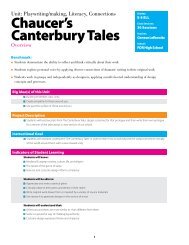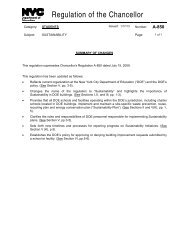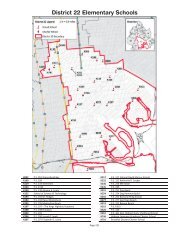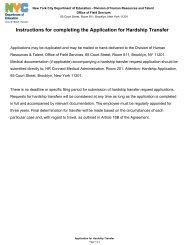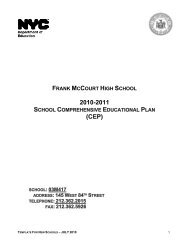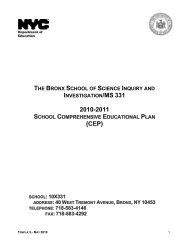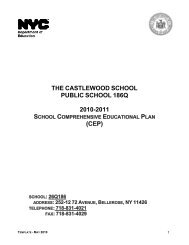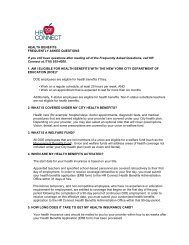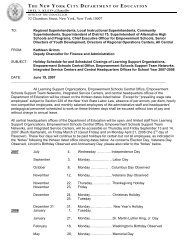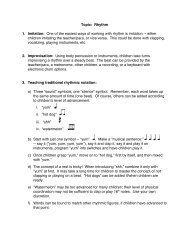Who Is to Blame for Romeo and Juliet's Death? - New York City ...
Who Is to Blame for Romeo and Juliet's Death? - New York City ...
Who Is to Blame for Romeo and Juliet's Death? - New York City ...
Create successful ePaper yourself
Turn your PDF publications into a flip-book with our unique Google optimized e-Paper software.
Unit Outline<br />
INTRODUCTION: This unit outline provides an example of how <strong>to</strong> integrate per<strong>for</strong>mance tasks in<strong>to</strong> a<br />
unit. Teachers may (a) use this unit outline as it is described below; (b) integrate parts of it in<strong>to</strong> a<br />
currently existing curriculum unit; or (c) use it as a model or checklist <strong>for</strong> a currently existing unit on a<br />
different <strong>to</strong>pic. The length of the unit includes suggested time spent on the classroom instruction of lessons<br />
<strong>and</strong> administration of assessments. Please note that this framework does not include individual lessons.<br />
Grade 9 Literacy in English Language Arts: <strong>Who</strong> <strong>Is</strong> <strong>to</strong> <strong>Blame</strong> <strong>for</strong><br />
<strong>Romeo</strong> <strong>and</strong> Juliet’s <strong>Death</strong>?<br />
UNIT TOPIC AND LENGTH:<br />
‣ This contains a curriculum-embedded Common Core–aligned task <strong>and</strong> instructional<br />
supports. The task is the culminating assessment <strong>for</strong> an 8-week unit on the study of<br />
<strong>Romeo</strong> <strong>and</strong> Juliet. Throughout the unit, students read <strong>and</strong> discuss the play, read <strong>and</strong><br />
analyze critical essays, view video, <strong>and</strong> complete <strong>for</strong>mative assessments leading <strong>to</strong><br />
the final per<strong>for</strong>mance task where students argue an answer <strong>to</strong> the question: <strong>Who</strong> is<br />
<strong>to</strong> blame <strong>for</strong> <strong>Romeo</strong> <strong>and</strong> Juliet’s death?<br />
COMMON CORE LEARNING STANDARDS:<br />
Assessed by the task<br />
RL.9-10.1: Cite strong <strong>and</strong> thorough textual evidence <strong>to</strong> support analysis of what the text<br />
says explicitly, as well as inferences drawn from the text.<br />
W.9-10.1: Write arguments <strong>to</strong> support claims in an analysis of substantive <strong>to</strong>pics or texts,<br />
using valid reasoning <strong>and</strong> relevant <strong>and</strong> sufficient evidence.<br />
a. Introduce precise claim(s), distinguish the claim(s) from alternate or opposing<br />
claims, <strong>and</strong> create an organization that establishes clear relationships among claim(s),<br />
counterclaims, reasons, <strong>and</strong> evidence.<br />
b. Develop claim(s) <strong>and</strong> counterclaims fairly, supplying evidence <strong>for</strong> each while<br />
pointing out the strengths <strong>and</strong> limitations of both in a manner that anticipates the<br />
audience’s knowledge level <strong>and</strong> concerns.<br />
c. Use words, phrases, <strong>and</strong> clauses <strong>to</strong> link the major sections of the text, create<br />
cohesion, <strong>and</strong> clarify the relationships between claim(s) <strong>and</strong> reasons, between reasons<br />
<strong>and</strong> evidence, <strong>and</strong> between claim(s) <strong>and</strong> counterclaims.<br />
d. Establish <strong>and</strong> maintain a <strong>for</strong>mal style <strong>and</strong> objective <strong>to</strong>ne while attending <strong>to</strong> the<br />
norms <strong>and</strong> conventions of the discipline in which the student is writing.<br />
e. Provide a concluding statement or section that follows from <strong>and</strong> supports the<br />
argument presented.<br />
Additional st<strong>and</strong>ards addressed in the unit<br />
RI.9-10.5: Analyze in detail how an author’s ideas or claims are developed <strong>and</strong> refined by<br />
particular sentences, paragraphs, or larger portions of a text (e.g., a section or chapter).<br />
W.9-10.9: Draw evidence from literary or in<strong>for</strong>mational texts <strong>to</strong> support analysis,<br />
reflection, <strong>and</strong> research.<br />
8



